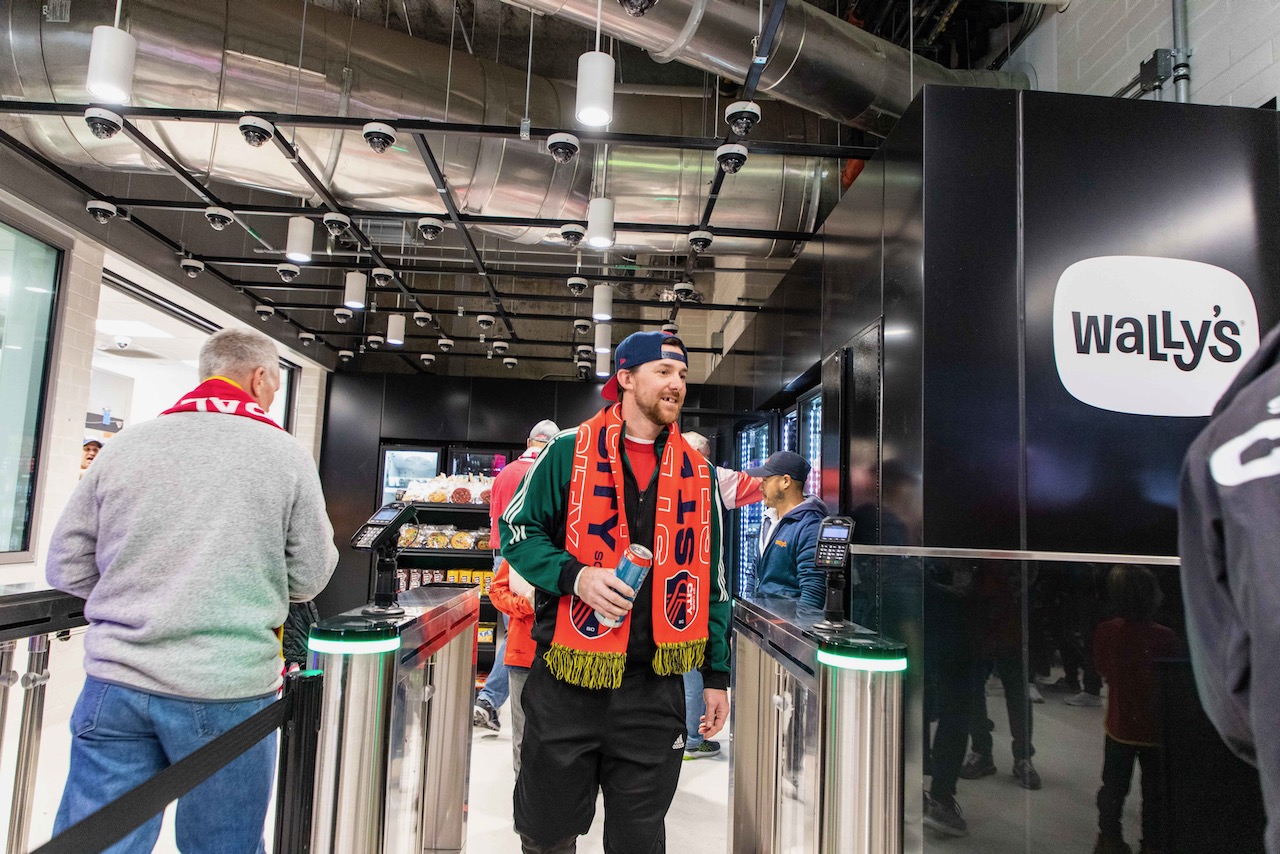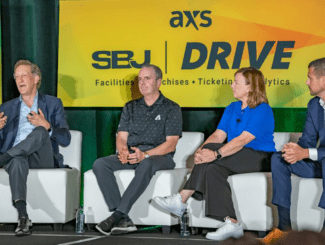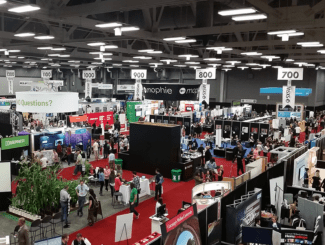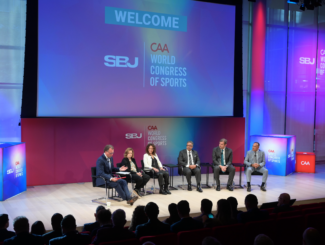When fans filter into T-Mobile Park in Seattle this year for Major League Baseball’s midsummer classic, they will have a chance to see the newest concessions All-Star — checkout-free stores — in action.
Three new Amazon Just Walk Out markets join one that was launched last season. The home of the Mariners has joined dozens of venues using checkout-free deployments to transform the food and beverage experience. Markets from providers like Amazon and Zippin allow fans to select products from store shelves and then bypass the checkout, automatically charging their preferred form of payment for their selection. The promise of this technology is a fast, accurate, frictionless commerce experience.
The rapid acceptance of cashier-less technology by venues and their fans is a sign that after years of failed promises, the concessions technology revolution is well underway. This Stadium Tech Report Market Report will focus on check-out-free stores. Who are the providers, how do they work, how do they benefit venues and guests, and what challenges they pose for the concessionaires.
Why checkout-free: Faster service, more revenue
For years, fans have accepted long lines, slow service, and inaccurate menus as part of the stadium concessions experience. Empowered by consumer behavior changes post-Covid, stadiums are deploying multiple technologies to speed up and improve the process. While there were experiments before the pandemic, preferences for social distancing, fewer lines and less human interaction have ignited an explosion of new concession technology.
Any fan who has been to sporting events in the past can easily grasp the benefits of a checkout-free concession stand. Instead of having to wait in a long line, missing critical chunks of the event they paid to attend, they can obtain food and drinks in seconds rather than minutes.
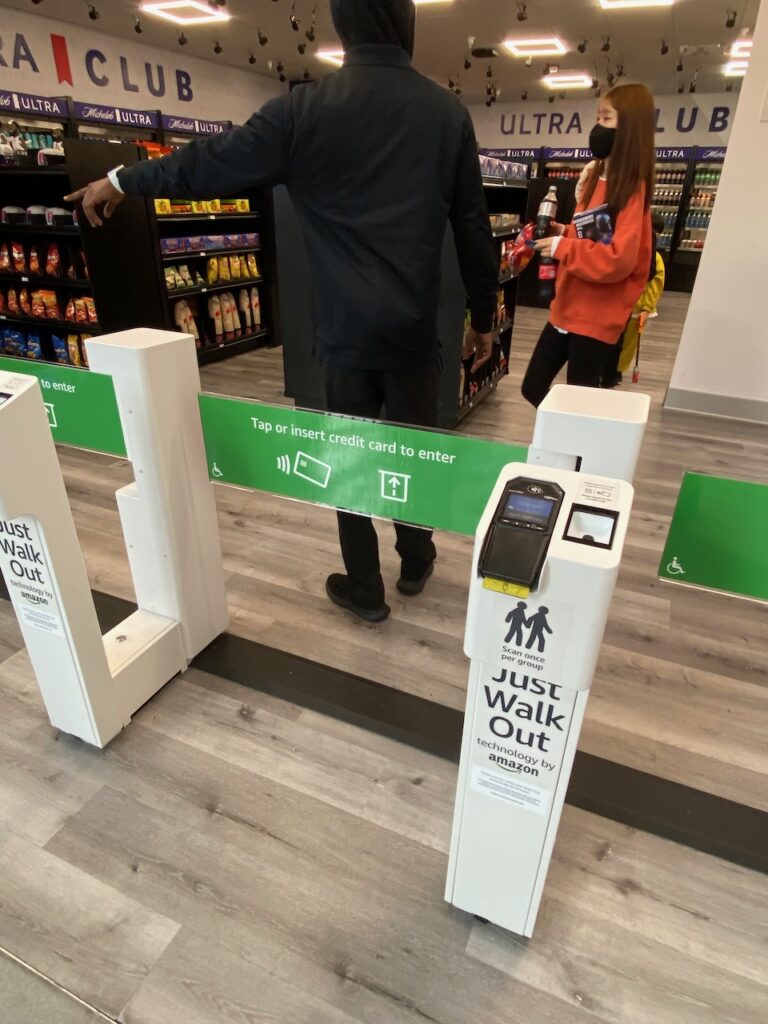
While the fan’s first engagement with such a store can be confusing, the learning curve is rapid, with many fans finding they can visit a concession multiple times simply because they’re back in their seats so quickly. The technology adds an element of surprise and fun to something that is is otherwise an everyday activity, prompting some fans to stop and take photos or videos of their checkout-free experiences.
For venues, the checkout-free stand is a godsend in an era where it’s increasingly hard to find enough people to fully staff a stadium for game days. Instead of needing a full team of order takers and food runners to process orders, checkout-free stands can operate with as few as one or two outside staff offering instructions to newcomers and to checking IDs for alcohol purchases.
Not surprisingly, with faster transactions, checkout-free stands are showing increased per-cap revenues according to early adopters who have shared prelimanary statistics.
Aside from the staffing and speed benefits, some venues are finding opportunities to apply the technology to previously unused space. By deploying the slimmer versions of stands that focus on drinks and prepackaged snacks venues are generating new revenue. At Barclays Center, where the venue has deployed several Zippin-powered stands, Zippin execs claim that stands built under vacant stairwells now generate as much as $10,000 per stand per event.
How does it work?
If you’re not familiar with checkout-free stores, here’s a quick primer. Customers are allowed to enter stores by scanning a credit card or some other pre-authorized payment method. After entring the store’s gate they simply take the items they want off the shelves and then exit. Payment takes place online after they leave the store.
In stadiums, the setup typically involves a secured area accessed via a set of gates (similar to public-transportation turnstiles) through which fans enter and exit. Entry requires the fan to present some method of identification linked to a payment card — this can be a physical credit card; a team/venue app; or with Amazon you can even use your palm assuming you’ve pre-registered for their Amazon One service. When the gate turns green you enter, select your items and leave through the exit gates.
What happens while you are there? A network of overhead cameras tracks customer activity. Camera data is paired with an artificial-intelligence engine that visually matches selected items to a pricing database. Some companies add shelf sensors to provide additional data and to improve accuracy. All providers claim their technology is accurate even if customers pick up an item and put it back. According to the companies, the cameras do not use facial recognition or any other type of permanent identification Instead, they match activity with a customer “shape” that is linked to the entry transaction.

While these systems promise to greatly reduced staffing requirements in venues, some live staffing is required. Staffing is present to help consumers who have not used the stores before, and to check IDs for alcohol purchases.
Who are the players in the market?
In the stadium market, the two leading providers of checkout-free stores are Zippin with 56 stores, and Amazon with 41. But the stadium-specific deployments are just a small slice of the overall market for checkout-free technology, which has attracted a strong field of global competitors.
Amazon’s deployment of the technology in some of the full-size Whole Foods stores is well publicized but other providers have deployed checkout-free technology in full-size stores, convenience stores, gas stations, college campuses, and on airport concourses. Here’s a quick rundown on the leading providers of checkout-free technology so far:
AMAZON
As the owner of the Whole Foods grocery chain, Amazon’s Just Walk Out technology is designed for more places that just stadium stores. That said, like some other providers Amazon is probably finding stadiums to be a good place to test systems since you don’t have to build out a full-size store to start getting some results. At last count Amazon had 41 open or announced stadium stores, including four outlets at each of the large venues close to its Seattle headquarters — Climate Pledge Arena, Lumen Field, and T-Mobile Park.
ZIPPIN
A San Mateo, Calif.-based startup, Zippin is the leader in stadium-specific deployments, with 56 such stores at our last count. Zippin last raised funding with a $30 million round in September of 2021, putting its total venture funding at $45 million. In January Zippin introduced the Zippin Walk-Up, a design that combines checkout-free technology with an existing concession stand, with no physical change needed to the stand.
AIFI
The Santa Clara, Calif.-based AiFi, which is backed in part by Verizon Ventures, raised $65 million in a series B round in March 2022 for a total of $80 million raised so far. Currently AiFi has six known permanent store deployments, along with some portable stores. AiFi recently signed a deal to provide checkout-free stores at the Intuit Dome, which is scheduled to open next year.
STANDARD AI
Formerly known as Standard Cognition, this San Francisco-based firm has been around since 2017, with more than $230 million of funding raised so far. In addition to launching its technology at convenience stores and campus stores, Standard AI is used at two stadiums — American Airlines Arena in Dallas, where there are two Standard AI stores, and at one store at Polar Park, the home of the minor-league Worcester (Mass.) Red Sox.
TRIGO
The Tel Aviv-based Trigo has partnered with several large grocery chains in Europe and the U.K. to deploy its checkout-free technology, including Tesco in the U.K. and ALDI in the Netherlands. Trigo raised an additional $100 million in venture capital this past October, bringing its total venture funding to $204 million. It currently has no known stadium stores using its technology.
GRABANGO
UPDATE, 10/9/24: Grabango is closing its doors after failing to secure more funding, according to reports.
The Berkeley, Calif.-based Grabango had deployed its checkout-free technology in several convenience store chains, including Circle K and AM/PM. The company raised $39 million in a series B funding round in June 2021, putting total funding near $94 million. It currently has no known stadium stores using its technology.
Upfront deployment costs a concern for some venues
While the number of sports-specific checkout-free stands seems to still be growing rapidly, the technology is not a slam-dunk for all venues. The biggest drawback, according to sources at several venues, is the upfront cost of the stores. Deployments require special cameras and sensors and can also require extensive physical renovation of stadium spaces.
For a full-size checkout-free store, offering not just drinks but hot food selections and merchandise, physical renovation costs may run $300,000 or more, according to several sources. In addition to designing for the entry and exit gates and putting in overhead cameras and shelf sensors, the stores must have ways for staff to provide fresh-cooked food or to stock coolers, preferably from the back so that staff is not interrupting customer flow.

Some providers, especially Zippin and AiFi, have responded to the cost concerns by designing smaller stores, like the “drink lane” design. This concept encapsulates a line of beverage coolers or a short bar featuring pre-filled drinks, coupled with a shelf or two for prepackaged snacks.
This January Zippin introduced an even smaller model of its stand, adding the entry/exit gates to an existing concession counter, with smaller coolers and food shelves perched on the existing countertops. AiFi has a similar model, which incorporates draft beer or fountain drinks poured behind a counter. AiFi has deployed several of its box-like “popup store” models at venues including Hard Rock Stadium in Miami, Ford Field in Detroit, and at the Indy 500.
These systems are sold on a subscription model, typically requiring a contract that is a year or more in length. Therefore, venues that only host a small number of events (e.g. college football stadiums and race tracks) may find it harder to find the return from checkout-free technology. The hope for the vendors is that their smaller-sized options may be priced reasonably enough for venues to be willing to kick the tires and see if the benefits are worth the upfront investment.
Refining placement and adding more stores
While the technology providers in the stadium space almost all tout their offerings as something that can “eliminate” concession lines, what we have seen in the field is that the popularity of these stands can sometimes create lines outside the gates with fans lined up for a quick transaction suggesting more stores may be necessary to handle demand.
At Denver’s Empower Field at Mile High, caterer Aramark experimented early on with a few Zippin stores and now has nine checkout-free stands, the most of any stadium. Since STR began tracking the technology we have seen several stadiums, including Lumen Field and T-Mobile Park in Seattle, start with one stand and then add several more in quick succession. At the new CityPark soccer stadium in St. Louis, early fan acceptance of the three Zippin stores has stadium operators already thinking about adding more in the future.

Placement strategies for stores are also evolving as more live-interaction data become available. At Allegiant Stadium in Las Vegas, the stadium placed two sets of Zippin drink stands side-by-side, directly across from traditional belly-up concession stands serving the upper-bowl seating. According to the venue, the Zippin stands completely eliminated long lines at belly-up stands by moving people who only wanted drinks and maybe a snack out of the lines of people looking for something more substantial.
Looking ahead to football season
With more expected new deployments to be announced in the coming months, the real expansion for checkout-free stores in the stadium space may take place before the U.S. football seasons arrive in the fall. What will be interesting from a business standpoint is to see if the two stadium-focused startups — Zippin and AiFi — will be able to continue to compete with the resources of Amazon. Or, if any of the other players, like Standard AI, Grabandgo, or Trigo, will expand into the U.S. stadium market. While checkout-free technology may not be a fit for all types of venue concession operations, it will be interesting to observe over time how many traditional belly-up stands are replaced by stands where fans simply walk through.



